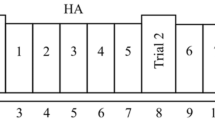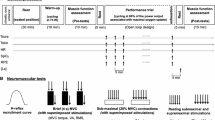Abstract
Muscle weakness following constant load exercise under heat stress has been associated with hyperthermia-induced central fatigue. However, evidence of central fatigue influencing intense self-paced exercise in the heat is lacking. The purpose of this investigation was to evaluate force production capacity and central nervous system drive in skeletal muscle pre- and post-cycle ergometer exercise in hot and cool conditions. Nine trained male cyclists performed a 20-s maximal voluntary isometric contraction (MVC) prior to (control) and following a 40-km time trial in hot (35°C) and cool (20°C) conditions. MVC force production and voluntary activation of the knee extensors was evaluated via percutaneous tetanic stimulation. In the cool condition, rectal temperature increased to 39.0°C and reached 39.8°C in the heat (P < 0.01). Following exercise in the hot and cool conditions, peak force declined by ~90 and ~99 N, respectively, compared with control (P < 0.01). Mean force decreased by 15% (hot) and 14% (cool) (P < 0.01 vs. control). Voluntary activation during the post-exercise MVC declined to 93.7% (hot) and 93.9% (cool) (P < 0.05 vs. control). The post-exercise decline in voluntary activation represented ~20% of the decrease in mean force production in both conditions. Therefore, the additional increase in rectal temperature did not exacerbate the loss of force production following self-paced exercise in the heat. The impairment in force production indicates that the fatigue exhibited by the quadriceps is mainly of peripheral origin and a consequence of the prolonged contractile activity associated with exercise.





Similar content being viewed by others
References
Allen DG (2009) Fatigue in working muscles. J Appl Physiol 106:358–359
Baker AJ, Kostov KG, Miller RG, Weiner MW (1993) Slow force recovery after long-duration exercise: metabolic and activation factors in muscle fatigue. J Appl Physiol 74:2294–2300
Bigland-Ritchie B, Jones DA, Hosking GP, Edwards RHT (1978) Central and peripheral fatigue in sustained maximum voluntary contractions of human quadriceps muscle. Clin Sci Mol Med 54:609–614
Bigland-Ritchie B, Johansson RS, Lippold OC, Woods JJ (1983) Contractile speed and EMG changes during fatigue of sustained maximal voluntary contractions. J Neurophysiol 50:313–324
Borg GA (1982) Psychophysical bases of perceived exertion. Med Sci Sports Exerc 14:377–381
Brück K, Olschewski H (1987) Body temperature related factors diminishing the drive to exercise. Can J Physiol Pharmacol 65:1247–1280
Daanen HA, van Es E, de Graaf JL (2006) Heat strain and gross efficiency during endurance exercise after lower, upper or whole body precooling in the heat. Int J Sports Med 27:379–388
Davies CT, Young K (1983) Effect of temperature on the contractile properties and muscle power of triceps surae in humans. J Appl Physiol 55:191–195
Davies CMT, Mecrow IK, White MJ (1982) Contractile properties of the human triceps surae with some observations on the effects of temperature and exercise. Eur J Appl Physiol Occup Physiol 49:255–269
Degroot M, Massie BM, Boska MD, Gober J, Miller RG, Weiner MW (1993) Dissociation of [H+] from fatigue in human muscle detected by high time resolution 31P-NMR. Muscle Nerve 16:91–98
Edwards RHT (1975) Muscle fatigue. Postgrad Med J 51:137–143
Edwards RH, Harris RC, Hultman E, Kaijser L, Koh D, Nordesjö LO (1972) Effect of temperature on muscle energy metabolism and endurance during successive isometric contractions, sustained to fatigue, of the quadriceps muscle in man. J Physiol 220:335–352
Edwards RG, Hill DK, Jones DA (1977) Fatigue of long duration in human skeletal muscle after exercise. J Physiol 272:769–778
Enoka R, Stuart DG (1992) Neurobiology of muscle fatigue. J Appl Physiol 72:1631–1648
Fitts RI (1994) Cellular mechanisms of muscle fatigue. Physiol Rev 74:49–94
Fuller A, Carter RN, Mitchell D (1998) Brain and abdominal temperature at fatigue in rats exercising in the heat. J Appl Physiol 84:877–883
Gandevia SC (2001) Spinal and supraspinal factors in human muscle fatigue. Physiol Rev 81:1725–1789
González-Alonso J, Teller C, Andersen SL, Jensen FB, Hyldic T, Nielsen B (1999) Influence of body temperature on the development of fatigue during prolonged exercise in the heat. J Appl Physiol 86:1032–1039
Hettinga FJ, De Koning JJ, de Vrijer A, Wüst RC, Daanen HA, Foster C (2007) The effect of ambient temperature on gross-efficiency in cycling. Eur J Appl Physiol 101:465–471
Hunter AM, St Clair Gibson A, Mbambo Z, Lambert MI, Noakes TD (2002) The effects of heat stress on neuromuscular activity during endurance exercise. Pflügers Arch 444:738–743
Jackson AS, Pollock ML (1978) Generalized equations for predicting body density of men. Br J Nutr 40:497–504
Jeukendrup A, Brouns F, Wagenmakers AJ, Saris WH (1997) Carbohydrate-electrolyte feedings improve 1 h time trial cycling performance. Int J Sports Med 18:125–129
Jones DA, Newham DJ, Torgan C (1989) Mechanical influences on long-lasting human muscle fatigue and delayed-onset pain. J Physiol 412:415–427
Kay D, Marino FE, Cannon J, St Clair Gibson A, Lambert M, Noakes TD (2001) Evidence for neuromuscular fatigue during high-intensity cycling in warm, humid conditions. Eur J Appl Physiol 84:115–121
Kent-Braun JA (1999) Central and peripheral contributions to muscle fatigue in humans during sustained maximal effort. Eur J Appl Physiol Occup Physiol 80:57–63
Kent-Braun JA, Le Blanc R (1996) Quantitation of central activation failure during maximal voluntary contractions in humans. Muscle Nerve 19:861–869
Lamb GD (2009) Mechanisms of excitation–contraction uncoupling relevant to activity-induced muscle fatigue. Appl Physiol Nutr Metab 34:368–372
Merton PA (1954) Voluntary strength and fatigue. J Physiol 123:553–564
Miller RG, Boska MD, Moussavi RS, Carson PJ, Weiner MW (1988) 31P nuclear magnetic resonance studies of high energy phosphates and pH in human muscle fatigue. Comparison of aerobic and anaerobic exercise. J Clin Invest 81:1190–1196
Miller M, Downham D, Lexell J (1999) Superimposed single impulse and pulse train electrical stimulation: A quantitative assessment during submaximal isometric knee extension in young, healthy men. Muscle Nerve 22:1038–1046
Mitchell JW, Nadel ER, Stolwijk JA (1972) Respiratory weight losses during exercise. J Appl Physiol 32:474–476
Morrison S, Sleivert GG, Cheung SS (2004) Passive hyperthermia reduces voluntary and isometric force production. Eur J Appl Physiol 91:729–736
Moss RL, Diffee GM, Greaser ML (1995) Contractile properties of skeletal muscle fibers in relation to myofibrillar protein isoforms. Rev Physiol Biochem Pharmacol 126:1–63
Nielsen B, Nybo L (2003) Cerebral changes during exercise in the heat. Sports Med 33:1–11
Nielsen B, Hales JRS, Strange S, Christensen NJ, Warberg J, Saltin B (1993) Human circulatory and thermoregulatory adaptations with heat acclimation and exercise in a hot, dry environment. J Physiol 460:467–485
Nybo L (2007) Exercise and heat stress: cerebral challenges and consequences. Prog Brain Res 162:29–43
Nybo L, Nielsen B (2001) Hyperthermia and central fatigue during prolonged exercise in humans. J Appl Physiol 91:1055–1060
Périard JD, Cramer MN, Chapman PG, Caillaud C, Thompson MW (2010) Cardiovascular strain impairs prolonged self-paced exercise in the heat. Exp Physiol. doi:2010.054213
Pugh LGCE, Corbett JL, Johnson RH (1967) Rectal temperatures, weight losses, and sweat rates in marathon running. J Appl Physiol 23:347–352
Rowell LB (1993) Human cardiovascular control. Oxford University Press, New York
Saboisky J, Marino FE, Kay D, Cannon J (2003) Exercise heat stress does not reduce central activation to non-exercised human skeletal muscle. Exp Physiol 88:783–790
Stackhouse SK, Dean JC, Lee SCK, Binder-MacLeod SA (2000) Measurement of central activation failure of the quadriceps femoris in healthy adults. Muscle Nerve 23:1706–1712
Tatterson AJ, Hahn AG, Martin DT, Febbraio MA (2000) Effects of heat stress on physiological responses and exercise performance in elite cyclists. J Sci Med Sport 3:186–193
Thomas MM, Cheung SS, Elder GC, Sleivert GG (2006) Voluntary muscle activation is impaired by core temperature rather than local muscle temperature. J Appl Physiol 100:1361–1369
Todd G, Butler JE, Taylor JL, Gandevia SC (2005) Hyperthermia: a failure of the motor cortex and the muscle. J Physiol 563:621–631
Tornvall G (1963) Assessment of physical capabilities with special reference to the evaluation of maximal voluntary isometric muscle strength and maximal working capacity. Acta Physiol Scand 58
Walters TJ, Ryan KL, Tate LM, Mason PA (2000) Exercise in the heat is limited by a critical internal temperature. J Appl Physiol 89:799–806
Westerblad H, Duty S, Allen DG (1993) Intracellular calcium concentration during low-frequency fatigue in isolated fibres of mouse skeletal muscle. J Appl Physiol 75:382–388
Acknowledgments
The authors thank Dr. Mike White and Dr. Martin Lakie for their constructive technical comments regarding percutaneous electrical stimulation. We also thank all the subjects who participated in this investigation, and Fionnuala Crowe and Carol Finn for their help with data collection. This research was supported by the University of Sydney Faculty of Health Sciences.
Conflict of interest
The authors declare that they have no conflict of interest.
Author information
Authors and Affiliations
Corresponding author
Additional information
Communicated by Toshio Moritani.
Rights and permissions
About this article
Cite this article
Périard, J.D., Cramer, M.N., Chapman, P.G. et al. Neuromuscular function following prolonged intense self-paced exercise in hot climatic conditions. Eur J Appl Physiol 111, 1561–1569 (2011). https://doi.org/10.1007/s00421-010-1781-3
Accepted:
Published:
Issue Date:
DOI: https://doi.org/10.1007/s00421-010-1781-3




